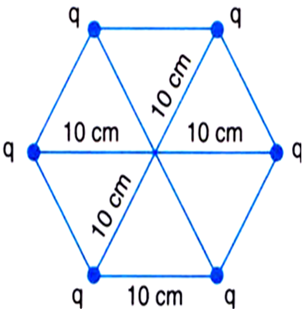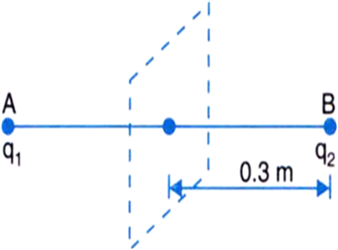Sponsor Area
Electrostatic Potential and Capacitance
Two charges 5 x 10–8C and –3 x 10–8 C are located 16 cm apart. At what point(s) on the line joining the two charges is the electric potential zero? Take the potential at infinity to be zero.
Given,
Charge, q1=
Charge, q2=–3 x 10–8 C
Distance between the two charges, d= 16 cm
The possibility of point where total potential due to q1 and q2 is zero may be that point which lies out side the segment joining q1 and q2.
Let required point P lies 'x' distance away from and (x-0.16) distance away from q2 so that .
where, V1 is the potential at point P due to charge q1 and,
V2 is the potential at point P due to charge q2.
Now, using the forlmula for electrostatic potential at a given point we get,
That is, the required point is 40 cm away from q1 and (40 – 16) = 24 cm from q2 such that, potential is 0.
A regular hexagon of side 10 cm has a charge 5 μC at each of its vertices. Calculate the potential at the centre of the hexagon.
Given,

Potential at the centre of the hexagon is given by
Two charges 2μC and –2μC are placed at points A and B, 6 cm apart.
(a) Identify an equipotential surface of the system.
(b) What is the direction of electric field at every point on this surface?
Given two charges placed at points A and B.

i.e., the plane normal to AB and passing through its mid-point has zero potential everywhere.
(b) The direction of electric field is normal to the plane in the AB direction.
A spherical conductor of radius 12 cm has a charge of 1.6 x 10–7 C distributed uniformly on its surface. What is the electric fields
(a) inside the sphere,
(b) just outside the sphere,
(c) at a point 18 cm from the centre of the sphere?
Given,
(a) Since, charge resides on the outer surface of the sphere, magnitude of electric field is 0 inside.
(b) Electric field just outside the sphere is given by
(c) At a point 0.18 m from the centre of the sphere
Sponsor Area
Mock Test Series
Mock Test Series





